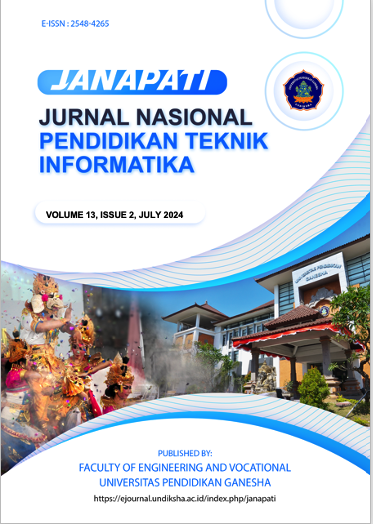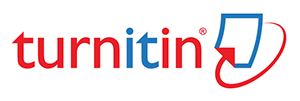Enhancing K-Means Clustering Model to Improve Rice Harvest Productivity Areas in Aceh Utara Using Purity
DOI:
https://doi.org/10.23887/janapati.v13i2.78254Keywords:
Optimization, Purity, Clustering, K-Means, Davies-Bouldin IndexAbstract
To optimize the performance of the clustering process using K-Means, an optimalization approach employing the Purity algorithm is needed. This research was tested on a dataset of rice harvest productivity areas in Aceh Utara Regency by comprehensively analyzing the number of iterations and the DBI values produced by K-Means and Purity K-Means in clustering priority and non-priority rice production areas. This is in line with the efforts of the Regional Government to implement rice production intensification programs in Aceh Utara Regency. From the testing of Purity K-Means, an average of 5, 2, 2, 5, and 3 iterations were obtained from all tested datasets sequentially from 2019 to 2023. Meanwhile, from the testing of conventional K-Means, the average number of iterations obtained was 5.4, 4.8, 4.2, 5.6, and 3.8 iterations, sequentially. This indicates that the clustering performance conducted by Purity K-Means is better than conventional K-Means. The DBI values obtained from Purity K-Means for the entire dataset sequentially are 0.6781, 0.4175, 0.4419, 0.6182, and 0.4973. This value is lower compared to the DBI values obtained from conventional K-Means, which are 0.7178, 0.6025, 0.4971, 0.7222, and 0.5519, respectively. This also indicates that the validity level of the clustering results performed by Purity K-Means is higher than conventional K-Means.
References
E. Suryani, R. A. Hendrawan, I. Muhandhis, and R. Indraswari. A simulation model to improve the value of rice supply chain (A case study in East Java-Indonesia). Journal of Simulation. 2022; 16(4): 392-414..
N. Liundi, A. W. Darma, R. Gunarso, and H. L. H. S. Warnars. Improving rice productivity in Indonesia with artificial intelligence. 7th International Conference on Cyber and IT Service Management (CITSM). 2019; 1-5.
Kantor Dinas Pertanian dan Pangan Kabupaten Aceh Utara. 2024.
K. P. Sinaga, and M. S. Yang. Unsupervised K-Means clustering algorithm. IEEE Access 8. 2020; 80716-80727.
T. M. Ghazal. Performances of k-means clustering algorithm with different distance metrics. Intelligent Automation & Soft Computing. 2021; 30(2): 735-742.
F. Marissa, A. Zahma, A. M. Bau, E. Noviansa, A. S. Neno, A. Lidya, and Maukar. Digitasi Produktivitas Panen Padi Berbasis K-Means Clustering. SMARTICS Journal. 2021; 7(1): 21-26.
C. J. Silalahi, A. Situmorang, and J. F. Naibaho. Implementasi Metode K-Means Clustering Untuk Memetakan Daerah Potensial Penghasil Padi di Provinsi Sumatera Utara. Methotika: Jurnal Ilmiah Teknik Informatika. 2022; 2(2): 49-57.
E. A. P. Putri. K-Means Clustering untuk pengelompokan daerah penghasil padi di Indonesia berdasarkan luas panen, produksi, dan produktivitas padi tahun 2022. Maliki Interdisciplinary Journal (MIJ). 2024; 2(1): 128-137.
B. Kristanto, A. T. Zy, and M. Fatchan. Analisis Penentuan Karyawan Tetap Dengan Algoritma K-Means dan Davies Bouldin Index. Bulletin of Information Technology (BIT). 2023; 4(1): 112-120.
M. Mughnyanti, S. Efendi, and M. Zarlis. Analysis of determining centroid clustering x-means algorithm with davies-bouldin index evaluation. IOP Conference Series: Materials Science and Engineering. 2020; 725(1): 012128.
F. Ros, R. Riad, and S. Guillaume. PDBI: A partitioning Davies-Bouldin index for clustering evaluation. Neurocomputing. 2023; 528: 178-199.
M. Ahmed, R. Seraj, and S. M. S. Islam. The k-means algorithm: A comprehensive survey and performance evaluation. Electronics. 2020; 9(8): 1295.
L. Nigro. Performance of parallel K-Means algorithms in Java. Algorithms. 2022; 15(4): 117.
L. K. Choi, K. B. Rii, and H. W. Park. K-Means and J48 Algorithms to Categorize Student Research Abstracts. International Journal of Cyber and IT Service. 2023; 3(1): 61-64.
X. Ran, X. Zhou, M. Lei, W. Tepsan, and W. Deng. A novel k-means clustering algorithm with a noise algorithm for capturing urban hotspots. Applied Sciences. 2021; 11(23): 11202.
S. Retno, N. Hasdyna, and B. Yafis. K-NN with Purity Algorithm to Enhance the Classification of the Air Quality Dataset. Journal of Advanced Computer Knowledge and Algorithms. 2024; 1(2): 42-46.
R. K. Dinata, N. Hasdyna, S. Retno, and M. Nurfahmi. K-means algorithm for clustering system of plant seeds specialization areas in east Aceh. ILKOM Jurnal Ilmiah. 2021; 13(3): 235-243.
S. Retno. Peningkatan Akurasi Algoritma K-Means dengan Clustering Purity Sebagai Titik Pusat Cluster Awal (Centroid). Thesis. 2019.
J. D. Sitompul, O. S. Sitompul, and P. Sihombing. Enhancement clustering evaluation result of davies-bouldin index with determining initial centroid of k-means algorithm. Journal of Physics: Conference Series. 2019; 1235(1): 012015.
N. Suarna, Y. A. Wijaya, T. Hartati, and T. Suprapti. Comparison K-Medoids algorithm and K-Means algorithm for clustering fish cooking menu from fish dataset. IOP Conference Series: Materials Science and Engineering. 2021; 1088(1): 012034.
F. B. Ashraf, A. Martin, M. S. R. Shafi, and M. U. Islam. An improved k-means clustering algorithm for multi-dimensional multi-cluster data using meta-heuristics. 24th International Conference on Computer and Information Technology (ICCIT). 2021; 1-6.
Downloads
Published
How to Cite
Issue
Section
License
Copyright (c) 2024 Sujacka Retno, Bustami, Rozzi Kesuma Dinata

This work is licensed under a Creative Commons Attribution-ShareAlike 4.0 International License.
Authors who publish with Janapati agree to the following terms:- Authors retain copyright and grant the journal the right of first publication with the work simultaneously licensed under a Creative Commons Attribution License (CC BY-SA 4.0) that allows others to share the work with an acknowledgment of the work's authorship and initial publication in this journal
- Authors are able to enter into separate, additional contractual arrangements for the non-exclusive distribution of the journal's published version of the work (e.g., post it to an institutional repository or publish it in a book), with an acknowledgment of its initial publication in this journal.
- Authors are permitted and encouraged to post their work online (e.g., in institutional repositories or on their website) prior to and during the submission process, as it can lead to productive exchanges, as well as earlier and greater citation of published work. (See The Effect of Open Access)







